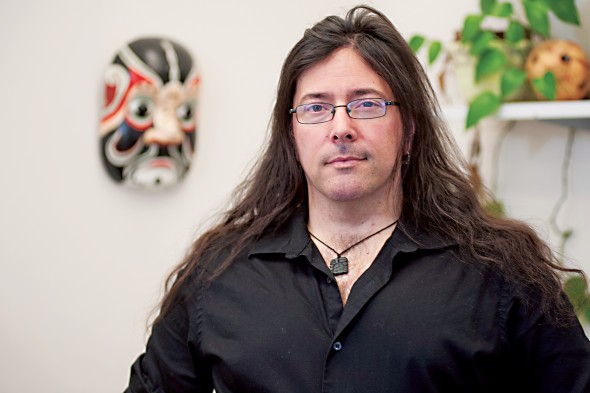Uncovering the history of POW camps in Chicago suburbs

James Meierhoff, graduate student in anthropology, is an expert on POW camps based in the northern suburbs during World War II, such as a camp at Fort Sheridan that held 4,000 German prisoners. Photo: Joshua Clark/UIC Photo Services
James Meierhoff’s study of Mayan refugees for his Ph.D. led his father to say, “You know 2,000 years of ancient Guatemalan history, but you know nothing about Chicago or Illinois.”
It got Meierhoff looking around his own backyard.
When he learned that thousands of German prisoners of war were held in the northern suburbs during World War II, he was fascinated. Before long, he became an expert on the subject, sharing what he learned in lectures to suburban audiences.
By far the largest POW camp was at Fort Sheridan, where 4,000 German prisoners were held in barracks that had emptied out when the war began. Elsewhere in the northern suburbs, much smaller camps, with names like Camp Pine, Camp Thornton and Camp Skokie Valley, housed 200 or so.
“The camps were built specifically to put the prisoners to work in local industries, mainly agriculture,” Meierhoff said.
One such business was Pesche’s Garden Center, a 7-acre plant nursery that still operates in Des Plaines on the site of what was Camp Pine during the war.
At the Des Plaines Historical Society, Meierhoff discovered photos of local growers and POWs at Camp Pine, waving and smiling at the camera.
“They had to hire 10 [prisoners] at a time, for at least a week,” he said. “So you had 10 to 40 guys, at the going rate for labor.”
Being in one of these POW camps was very little like being in prison. The book Stalag Wisconsin, by Betty Cowley, notes that many of the prisoners blended with the local community, drinking at taverns and dating local women.
Their familiarity with residents caused resentment among returning American soldiers, Cowley writes.
In the north suburbs, Meierhoff said, “The Germans got along surprisingly well with citizens, after an initial nervousness. This was probably because a lot of local families were of German extraction.”
The prisoners could listen to the radio and buy newspapers and magazines, unlike their American POW counterparts in German prison camps whose access to news was restricted.
Tales of escape
Security was lax enough that occasionally a German prisoner managed to escape. Meierhoff heard the tale of one who disappeared and ended up working in a Chicago bookstore, which he later purchased. According to another story, an escapee who had no interest in returning to Germany, where his hometown was held by the Soviets, made his way to California and became a tennis pro.
Many of the prisoners liked living in this country so much that they returned at war’s end to become permanent residents, Meierhoff said.
Nationally, the U.S. government grossly underestimated how many German prisoners it would have to place in camps here. The number was thought to be 50,000 to 75,000, but ended up being 420,000 by the time the war was over.
Meierhoff, who lives in Morton Grove, grew up in the northwest suburbs and earned bachelor’s and master’s degrees at UIC.
He’s working on his Ph.D. in anthropology, studying Mayan refugees in Guatemala in the 1850s who fled a civil war known as the Caste War of Yucatan, in which native Mayans revolted against those of European descent.
“They were getting rid of the colonizers,” Meierhoff said. “One group that wanted to remove themselves from the violence fled to the jungle and built villages in Belize and Guatemala.”
When he started delving into local history, he also became interested in the Black Hawk War of 1832.
“It was the last Indian insurgency east of the Mississippi River,” he said. “And the last battle was fought in Illinois, in Kellogg’s Grove in Stephenson County.”
